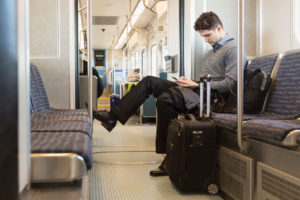By Chelsea Webster
We know that parking customers have many different needs. How do we cater to each group to maximize our customer loyalty and revenue? Does segmenting our offerings by age group produce results? If you’re willing to explore age segmentation in the parking industry, here’s a group with some unique characteristics that’s worth a second thought: Xennials.
What is a Xennial?
Xennials are a micro-generation that exists for those folks born between 1977-1985 (me!), bridging the gap between millennials (we embrace technology, have positive outlooks, and care about the greater good) and Gen-Xers (we had dial up internet and didn’t get cell phones until our 20’s). We grew up with an analog childhood and matured into a digital adulthood. The best line I’ve read describing xennials so far is “As we were growing up, technology matured along side us. We had time to get used to it and were still young enough to feel right at home with it.” Best of all, the existence of this peer group gives us the ultimate “I told you so” moment in emphasizing we are NOT millennials (Pro Tip #1: don’t talk to us like we are, as we really hate that).
How do Xennials Compare to Millennials, Gen X & Baby Boomers?
Age before beauty. Baby boomers – all 76 million of them in the US + 10 million more in Canada – are typically thought of as hardworking, team players, mentors, and being born into the right place at the right time; but also, not adaptable or collaborative. Gen-Xers, of whom there are 55 million in the US and another 7 million in Canada, are nostalgic geeks, adaptable, and good at problem solving; but are very individualistic and cynical. Millennials total 83 million in the US plus 10 million in Canada are very tech-savvy,…
By Ralph Bond
It seems that almost every week there is a news article about how the fast approaching world of autonomous vehicles (AV’s) will change the way we travel, impact on transportation related infrastructure – especially parking, and influence planning and design for urban real estate development. There is a wide divergence of opinion on when and how the impacts might occur and many unsubstantiated pronouncements. Nevertheless, an increasing number of developers as well as public sector agencies and municipalities are becoming concerned about the potential impacts and the risks associated with building new infrastructure that may not be suitable for the future.
The increased use of ride hailing services like Uber and Lyft is already reducing parking demand in varying degrees. For example, hotels in urban areas are reporting substantial reductions in parking demand because people are increasingly using ride-hailing services in place of rental cars. Some airports are also reporting significant declines in parking demand. More business people are using ride-hailing services in place of driving in some congested urban areas because it allows them to work while travelling and avoid the frustration of finding a parking space. Although these examples do not apply universally, it is an indication of how business related travel is changing when it comes to mobility in congested urban areas. We therefore prefer to think of the issue as the increased use of ride hailing services whether they are in autonomous vehicles or not.
Increasingly, both the public and private sector are asking questions such as:
- Do we really need this much parking?
- What is the risk that we will be stuck with a stranded parking asset?
- Can parking be designed for conversion to another use to mitigate the risk?
- Can increased use of shared public parking mitigate future risk?
- Will a lot more…
By Brett Bain
Historically, things in airports around parking and transportation have until the last few years, been static. Customers generally followed three standard options for getting to the airport. They drove themselves and parked their vehicle at the airport, they took a taxi or limousine, or they were dropped off by a friend or family member.
Airports in Canada – in most cases – are non-profit organizations that operate under a lease arrangement with the federal government. They do not receive any funding from the government to operate and in fact, pay a minimum of 10% of gross revenues in tax back to the federal government. In addition, they are also required to pay property tax to the jurisdiction in which they reside. As a result, Canadian airports are very reliant on the revenue generated from non-aviation sources which consists primarily of parking, concessions within the airport and real estate revenues. These revenues are reinvested back into the airport for operational expenses and for airport infrastructure and flight development.
Like many businesses, airports have been in transition over the last few years. If we think back a bit, we can all remember that at one time telephone, internet and cable companies were all separate entities which provided a product or service to their customers. These businesses have all blended together into single entities over the last few years as technology has created opportunities for companies to enter into new markets. Parking and transportation at airports are now in the early stages of a similar transformation as transit and/or rail services begin to appear in the airport offerings. Airports are both an economic driver for their region and a reflection of the community which they serve. As cities develop new and expanded forms of transportation to serve their citizens, these are also…
By Roamy Valera
The hottest buzz word among parking leaders right now is mobility. In fact, within and outside the industry, mobility is a primary concern for those who are tasked with shaping our communities. Accountability is being placed on those who impact our ability to move about freely, easily and safely in our urban environment. How we move however, is determined by urban planning for the future. And today, as we are on the cusp of the age of the smart city and self-driving vehicles, the future of mobility is taking shape.
Mobility is about providing efficient access to essential services, employment opportunities, and entertainment and recreational opportunities. For some, that means facilitating car travel; for some it means providing transit resources, as well as first and last mile service for transit users; and for some it means providing safe and convenient pedestrian access. The benefits of providing seamless mobility are enormous: more vibrant economic development, more sustainable communities, and a better quality of life for residents and visitors.
Parking is a critical element in the mobility piece and can make or break our ability to move around our environment efficiently. An estimated 30 percent of traffic in urban areas is caused by drivers looking for parking. How we leverage innovative technology to reduce this friction is key to solving this element and will allow those accountable to our journey to better manage the curb.
Curb Management is the Key
How we manage the curb matters. When vehicles are constantly circling blocks looking for parking, they cause congestion on roadways and pose a hazardous situation for fellow drivers and pedestrians alike. Likewise, when drivers double park, they create similar hazards. So, where do we start?
Curb management begins with Transportation Demand Management (TDM). TDM is a general term describing strategies designed to increase overall…
By Nigel Bullers
Car share is transforming how people think about their daily commuting needs and that is seen on the west coast more than any of the other market; Seattle, Portland and here in Canada, Vancouver is at the epicenter of the adoption of car share. Car share has evolved over the past decade, early adopters were people that cashed in their personal cars and headfirst into car share as the only option alongside public transit. Today the users are different, many of them have multiple vehicles at home and they hold multiple car share accounts. Car share has become part of a total transportation solution for drivers. Although these new users are slightly different than the early adopters, the needs remain the same – the desire for easy parking close to destinations and pick up points, and frictionless, quick parking solutions.
Parking at the destination
In downtown urban centers some of the parking facilities will be gated, as is true in Vancouver where Pacific Centre has some 1500 spaces exactly where car share users would like to go. But in the past, car share had challenges with gated lots and lots underground where they lost the signal and would lose cars and thus inventory.
Evo Car Share and EasyPark partnered to bring car share to Pacific Centre. The process entailed enhancements to the repeaters so that vehicles would not go dark when going underground, and by devising a solution for billing for the cars going in and out of the lot. The early program worked in a very basic way, whereby drivers would simply pull a ticket, leave that ticket on the dash and then the next driver would hand that ticket to the booth attendant, who would process the ticket. Evo was billed at…








